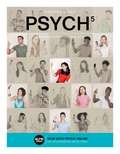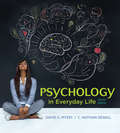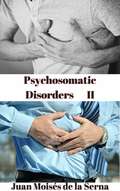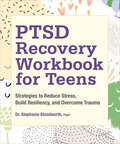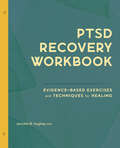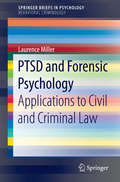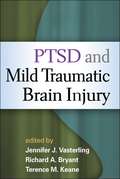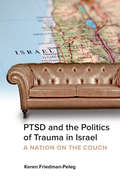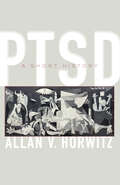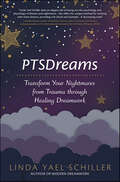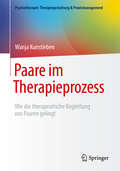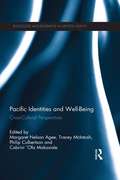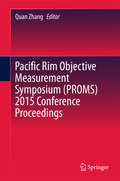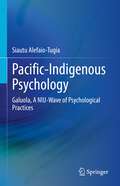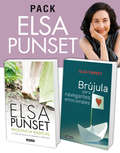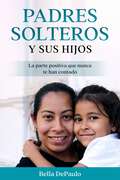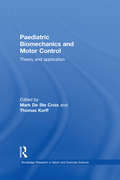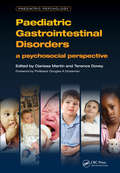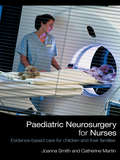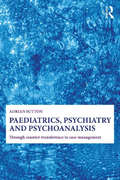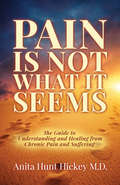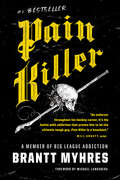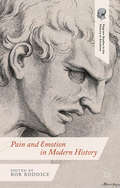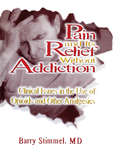- Table View
- List View
PSYCH 5: Introductory Psychology
by Spencer RathusPSYCH's easy-reference, paperback textbook presents course content through visually-engaging chapters as well as Chapter Review Cards that consolidate the best review material into a ready-made study tool.
PSYCHOLOGY in Everyday Life, Fourth Edition
by David G. Myers C. Nathan DewallDavid Myers' and Nathan DeWall’s best-selling and briefest introduction to psychology speaks to all students regardless of their background or level of preparedness, with no assumptions made in the vocabulary, examples, or presentation. Students of all kinds are comfortable with Myers' manageable chapters, which include careful connections to associated visuals, comparative tables, and research-based pedagogy. Psychology in Everyday Life is a high quality and affordable resource for students of all levels. The text and accompanying LaunchPad have been heavily updated to reflect psychological science and students’ everyday lives today.
PSYCHOSOMATIC DISORDERS II
by Juan Moises de la Serna Cristina MaroiuPsychosomatic pathologies lead many patients to wander from a medical office to another without finding a clear diagnosis of their condition, and above all without receiving the appropriate treatment, or discovering how to identify it and what is the best treatment for each case. Psychosomatic disorders have a complex clinical picture, are difficult to diagnose and require a global intervention in order to be treated. This text describes these types of disorders, how they affect one's health, what their causes are, and what types of therapeutic interventions can cure them.
PTSD Recovery Workbook for Teens: Strategies to Reduce Stress, Build Resiliency, and Overcome Trauma
by Dr. Stephanie Bloodworth PsyDHelp teens manage PTSD symptoms and move forward It can be hard for teenagers to move on after experiencing a difficult event. Fortunately, young people are more than their trauma. This workbook highlights how healing is possible, empowering teens to face their PTSD and learn to advocate for themselves. In this PTSD workbook teens will: Unpack PTSD—Teach teens what types of trauma cause PTSD, the specific impact it can have on them, and how symptoms may manifest mentally and physically. Heal through exploration—Discover activities and strategies to help teens process their triggers and traumas, from creating a sanctuary space to practicing setting healthy boundaries. Hear from other teens—Find reassurance in stories about other teenagers who have also experienced PTSD. Give teens the tools they need to work through their trauma and improve their mental health with this encouraging PTSD book.
PTSD Recovery Workbook: Evidence-based Exercises and Techniques for Healing
by Jennifer B. Hughes PhDUnderstand and overcome PTSD with proven healing exercises Recovering from PTSD is a gradual process that requires deep introspection and expert guidance—which means getting started can feel overwhelming. But this trauma workbook is here to ease your way, offering a safe space for you to learn how trauma and PTSD affect your brain and body, reflect on your experiences, and explore strategies to support your healing journey. What sets this PTSD workbook apart from other trauma books: A hands-on workbook format—Discover clear and organized advice paired with thought experiments, checklists, and writing prompts that help you identify your feelings and record your progress. Support for any type of trauma—Find the strength to navigate all kinds of trauma, whether it's from military combat, an abusive relationship, an accident, or anything else that's been difficult to overcome, no matter how big or small. A mix of therapy techniques—Try out strategies built on a variety of evidence-based recovery methods including cognitive behavioral therapy, somatic therapy, and exposure therapy. Face your past and cope with trauma—the PTSD Recovery Workbook is your first step.
PTSD and Forensic Psychology
by Laurence MillerIn World War I, they spoke of shell shock. By World War II, the term was battle fatigue. Modern understanding of trauma psychology has evolved to give the concept a non-military name: posttraumatic stress disorder. As such, it has been at the heart of civil and criminal cases from workers' compensation to murder. PTSD and Forensic Psychology brings its topic into real-world focus by examining posttraumatic stress as a clinical entity and taking readers through the evaluation process for court cases involving the PTSD syndrome. This timely reference differentiates between PTSD and disorders that may be mistaken for it, and demonstrates its legal application in seeking civil damages and mounting a criminal defense. An evidence-based framework for conducting a trial-worthy evaluation and guidelines for establishing strong cases and refuting dubious ones further illustrate the protocols and challenges surrounding the status of PTSD in legal settings. For maximum usefulness, the book offers courtroom advice for expert witnesses as well as "practice points" at the end of each chapter. Featured topics include: History of the PTSD concept and its relation to the law. PTSD as syndrome: symptoms, diagnosis, treatment. PTSD and other traumatic disability syndromes. PTSD in the civil litigation and criminal justice systems. PTSD as an insanity defense and in claims of diminished capacity. PTSD cases: evaluation, interpretation, testimony. This thorough yet concise analysis makes PTSD and Forensic Psychology the ideal training tool for beginning mental health expert witnesses, as well as a concise practical review and reference source for seasoned forensic psychologists. It will also serve as a useful practice and teaching guide for attorneys, medical rehabilitation professionals, military personnel, psychotherapists, researchers, and educators in the fields of clinical and forensic psychology, criminology, traumatic stress studies, and mental health law.
PTSD and Mild Traumatic Brain Injury
by Jennifer VasterlingEvents that lead to traumatic brain injury are often also psychologically traumatic. Addressing a growing need among mental health practitioners, this authoritative book brings together experts in both posttraumatic stress disorder (PTSD) and mild traumatic brain injury (mTBI). Chapters present empirically based best practices for conceptualization, assessment, and intervention. The book also addresses the biological and psychosocial mechanisms by which PTSD and mTBI complicate each other; management of commonly associated conditions, including chronic pain and substance abuse; special considerations in military contexts; and possible ways to improve the structure and cost-effectiveness of providing care in this challenging area.
PTSD and the Politics of Trauma in Israel: A Nation on the Couch
by Hebrew University Magnes Press Keren Friedman-PelegPost-Traumatic Stress Disorder, or PTSD, has long been defined as a mental trauma that solely affects the individual. However, against the backdrop of contemporary Israel, what role do families, health experts, donors, and the national community at large play in interpreting and responding to this individualized trauma? In PTSD and the Politics of Trauma in Israel, Keren Friedman-Peleg sheds light on a new way of speaking about mental vulnerability and national belonging in contemporary Israel. Based on ethnographic fieldwork conducted at The Israel Center for Victims of Terror and War and The Israel Trauma Coalition between 2004 and 2009, Friedman-Peleg’s rich ethnographic study challenges the traditional and limited definitions of trauma. In doing so, she exposes how these clinical definitions have been transformed into new categories of identity, thereby raising new dynamics of power, as well as new forms of dialogue.
PTSD: A Short History (Johns Hopkins Biographies of Disease)
by Allan V. HorwitzA comprehensive history of PTSD.Post-traumatic stress disorder—and its predecessor diagnoses, including soldier’s heart, railroad spine, and shell shock—was recognized as a psychiatric disorder in the latter part of the nineteenth century. The psychic impacts of train crashes, wars, and sexual shocks among children first drew psychiatric attention. Later, enormous numbers of soldiers suffering from battlefield traumas returned from the world wars. It was not until the 1980s that PTSD became a formal diagnosis, in part to recognize the intense psychic suffering of Vietnam War veterans and women with trauma-related personality disorders. PTSD now occupies a dominant place in not only the mental health professions but also major social institutions and mainstream culture, making it the signature mental disorder of the early twenty-first century. In PTSD, Allan V. Horwitz traces the fluctuations in definitions of and responses to traumatic psychic conditions. Arguing that PTSD, perhaps more than any other diagnostic category, is a lens for showing major historical changes in conceptions of mental illness, he surveys the conditions most likely to produce traumas, the results of those traumas, and how to evaluate the claims of trauma victims. Illuminating a number of central issues about psychic disturbances more generally—including the relative importance of external stressors and internal vulnerabilities in causing mental illness, the benefits and costs of mental illness labels, and the influence of gender on expressions of mental disturbance—PTSD is a compact yet comprehensive survey. The book will appeal to diverse audiences, including the educated public, students across the psychological and social sciences, and trauma victims who are interested in socio-historical approaches to their condition.Praise for Allan V. Horwitz’s Anxiety: A Short History"The definitive overview of the history of anxiety."—Bulletin of the History of Medicine"A lucid, erudite and brisk intellectual history driven by a clear and persuasive central argument."—Social History of Medicine"An enlightening tour of anxiety, set at a sensible pace, with an exceptional scholar and writer leading the way."—Library Journal
PTSDreams: Transform Your Nightmares from Trauma through Healing Dreamwork
by Linda Yael SchillerNightmares, especially those caused by trauma, not only disrupt your sleep but can leave you exhausted and on edge, haunting your daylight hours. With in-depth information on the nature of nightmares, international speaker, author, and psychotherapist Linda Yael Schiller shows you how to turn anxiety-filled or heart-pounding dreams into resources for spiritual growth. Her four decades of experience in both dreamwork and trauma treatment provide the reader with guidelines for turning PTSDreams into PTSG: Post Trauma Spiritual Growth.Therapists, counselors, medical professionals, and healers of all stripes, as well as the general public, are often woefully unprepared to deal with their own or their clients' nightmares. Dreamwork and connecting the dots between dreams, nightmares, and a trauma history simply isn't taught in most professional graduate schools. We do ourselves and clients a disservice if we don't have the tools and methods to bring relief from this suffering. PTSDreams offers these tools, informed by Eye Movement Desensitization and Reprocessing (EMDR) methods, to provide safe, non-triggering work and a Jungian active imagination approach that allows us to re-enter these dreams safely. This way, we can rework the dreams, resource the dreamer, and bring healing to both the nightmare and the root cause of the trauma.When unaddressed, these dark dreams can follow us around in other forms, sneaking in through the cracks and fissures of our consciousness until they are finally faced, comforted, and healed. As Jungian analyst Dr. Yorum Kaufman taught, an inability to find a place for these memories keeps us shackled to a constrained, Sisyphean world whereby our movement into the future is thwarted by these "forgotten" memories that keep pushing us back down the hill. While retrieving these memories is a psychological issue, learning to live with what we remember is a spiritual process.Who can benefit from addressing their nightmares? Victims of violence, refugees, veterans, childhood abuse survivors, victims of bullying and gender or racial violence, anyone with shattered or disrupted lives. Trauma can be personal, familial, ancestral, global, and environmental. Both current and historical trauma and stress can benefit from this healing work. Linda's technique is also being used internationally to help war trauma survivors.Armed with effective techniques and Linda's warm compassionate voice, you can learn to safely heal post-traumatic nightmares and their root causes. She teaches the Guided Active Imagination Approach (GAIA), a method she developed based on best-practice trauma treatment and Jungian active imagination principles. Through compelling case descriptions and thoughtful exercises, you will learn how to apply a multiplicity of integrated and embodied dreamwork techniques. Linda also provides somatic, narrative, and psycho-spiritual approaches. Combining neuroscience, healing, mysticism, and creativity, PTSDreams helps you transform nightmares into a new story: one of hope, healing, and life-affirming images.
Paare im Therapieprozess: Wie die therapeutische Begleitung von Paaren gelingt (Psychotherapie: Therapiegestaltung & Praxismanagement)
by Wanja KunstlebenDieses Buch ist für Sie als Therapeut und Therapeutin eine essentielle Stütze, um heikle Momente, eskalierende Konflikte und komplexe Dynamiken in der Arbeit mit Paaren souverän zu meistern. Der Autor stellt ein klares und effizientes Modell zur Navigation und Prozesssteuerung von Paartherapien vor. So finden Sie Orientierung und Steuerungskompetenz in diesem hochdynamischen Setting und können mit Selbstvertrauen Therapiesitzungen sicher gestalten und leiten. Das schulenübergreifende Modell gliedert sich in 3 Prozess-Dimensionen: Regulation, Klärung und Intimität. Anschaulich und nah am Erleben in der Praxis wird aufgezeigt, wie Sie als Therapeut oder Therapeutin sicher erkennen, um welche Prozessebene es in der Arbeit mit dem Paar gerade geht. Anhand von Beispielen, praktischen Übungen und einem breiten Spektrum an Methoden wird verständlich, wie Sie darauf antworten können. Lernen Sie, wie Sie spielerisch von einem Prozess-Modus in den anderen wechseln und Sie Ihre therapeutische Rolle flexibel anpassen. So können Sie sich und Ihre Klienten und Klientinnen entlasten und kompetent begleiten. Das Modell kann für die sichere Gestaltung von Paarsitzungen im Rahmen von Einzeltherapien ebenso genutzt werden wie für Paarberatungen und Paartherapien. Es besticht durch seine Klarheit und Effizienz und seinen hohen Wiedererkennungswert in der therapeutischen Arbeit. Dabei integriert der Autor verschiedene Ansätze und führt Sie wohlwollend und ermutigend durch das Modell und die Dynamiken von Paartherapien. Geraten Sie auch in herausfordernden Situationen nicht ins Schwimmen, sondern behalten den Überblick mit diesem hilfreichen Navigationstool!
Pacific Identities and Well-Being: Cross-Cultural Perspectives (Routledge Monographs in Mental Health)
by Philip Culbertson Margaret Nelson Agee Tracey McIntosh Cabrini 'Ofa MakasialeFilling a significant gap in the cross-cultural and cross-disciplinary literature within the field of Pasifika (Polynesian) and Maori identities and mental health, this volume focuses on bridging mental health related research and practice within the indigenous communities of the South Pacific. Much of the content reflects both differences from and relationships with the dominant Western theories and practices so often unsuccessfully applied with these groups. The contributors represent both experienced researchers and practitioners and address topics such as research examining traditional and emerging Pasifika identities; contemporary research and practice in working with Pasifika youth and adolescents; culturally-appropriate approaches for working with Pasifika adults; and practices in supervision that have been developed by Maori and Pasifika practitioners. Chapters include practice scenarios, research reports, analyses of topical issues, and discussions about the appropriateness of applying Western theory in other cultural contexts. As Pasifika cultures are still primarily oral cultures, the works of several leading Maori and Pasifika poets that give voice to the changing identities and contemporary challenges within Pacific communities are also included.
Pacific Rim Objective Measurement Symposium (PROMS) 2015 Conference Proceedings
by Quan ZhangThis book collects and organizes the original studies presented at PROMS 2015 conference on theories and applications of Rasch model. It provides useful examples of the Rasch model used to address practical measurement problems across a range of different disciplines including Item Response Theory (IRT), philosophy of measurement, dimensionality, the role of fit statistics and residuals, application, educational application, language testing, health-related research, business and industrial application and Rasch-based computer software. PROMS 2015 (Pacific Rim Objective Measurement Symposium) was held from August 20-24th 2015, in Fukuoka, Japan. The goal of this conference is to bring together the researchers from academia, universities, hospitals, industry, management sector as well as practitioners to share ideas, problems and solutions relating to the multifaceted aspects of Rasch Model.
Pacific-Indigenous Psychology: Galuola, A NIU-Wave of Psychological Practices
by Siautu Alefaio-TugiaThis book provides an overview of Pacific-Indigenous knowledge as insights of Oceanic citizen-science to inform culturally-safe practice for psychology. It profiles contemporary Pacific needs in areas of crisis such as family violence, education disparities and health inequities, and points to ancient Pacific-indigenous knowledges as tools of healing for global diasporic communities in need. The historical evolution of psychology’s knowledge base and practice illustrates a fundamental crisis in the method of producing knowledge for psychology - the absence of Pacific-indigenous cultural knowledge. It suggests more effective research methodologies grounded in Pacific-Indigenous epistemologies and ontologies for psychology and overall community capability. It fosters practice perspectives and strategies based on NIU-psychology (New Indigenous Understandings) for innovative solutions to modern-day crises of humanity.
Pack Elsa Punset (2 ebooks): Inocencia radical y Brújula para navegantes emocionales
by Elsa PunsetElsa Punset, experta en inteligencia emocional, nos ayuda a entender nuestras emociones, a enfrentarlas y a transformarlas en nuevas oportunidades de cambio. Elsa Punset nos habla en este pack del impacto de las emociones en la vida diaria. «Siempre quise arrancar las emociones del campo académico, de la fría disección, para llevarlas a las manos de las personas, a la vida real, al interior de cada uno de nosotros. Porque allí es donde importan, traspasan, duelen y transforman. Las emociones son el lenguaje universal con el cual sentimos, nos comunicamos, nos amamos o nos odiamos. Tenemos que lograr descifrarlas, amaestrarlas, disfrutarlas sin temor». Este pack contiene los títulos:- INOCENCIA RADICAL- BÚJULA PARA NAVEGANTES EMOCIONALES Inocencia radical:Nacemos inocentes, vulnerables, curiosos, dotados de la pasión por vivir. Cómo nos enfrentamos a estas etapas cruciales de nuestra existencia determinará el tejido de nuestras emociones. Elsa Punset nos alienta en Inocencia radical a sacar provecho de nuestra capacidad innata para amar y para transformar. Brújula para navegantes emocionales:En los últimos tiempos las emociones, gracias a las puertas abiertas por la neurociencia, pueden catalogarse, comprenderse e incluso gestionarse: son la llave de nuestro centro neurálgico. Conocerse a uno mismo permite descubrir las fuentes de nuestra felicidad, nuestra ira y nuestro dolor para poder convivir armoniosa y plenamente con nosotros mismos y con los demás.
Padres solteros y sus hijos: La parte positiva que nunca te han contado
by Bella DePauloPadres solteros y sus hijos es una recopilación de artículos que desmiente todos los estereotipos que desprecian y degradan a las familias monoparentales. Basándose en la investigación científica más rigurosa, la Dra. Bella DePaulo demuestra que las pésimas predicciones respecto al destino de los hijos de las familias monoparentales son exageradas o simplemente erróneas. Es más, hay aspectos en los que los hijos de padres solteros se desenvuelven mejor que los demás. Esta es la parte positiva que nunca te han contado.
Paediatric Biomechanics and Motor Control: Theory and Application (Routledge Research in Sport and Exercise Science)
by Mark De Ste Croix Thomas KorffPaediatric Biomechanics and Motor Control brings together the very latest developmental research using biomechanical measurement and analysis techniques and is the first book to focus on biomechanical aspects of child development. The book is divided into four main sections – the biological changes in children; developmental changes in muscular force production; developmental changes in the biomechanics of postural control and fundamental motor skills and finally the applications of research into paediatric biomechanics and motor control in selected clinical populations. Written by a team of leading experts in paediatric exercise science, biomechanics and motor control from the UK, the US, Australia and Europe, the book is designed to highlight the key implications of this work for scientists, educators and clinicians. Each chapter is preceded by a short overview of the relevant theoretical concepts and concludes with a summary of the practical and clinical applications in relation to the existing literature on the topic. This book is important reading for any sport or exercise scientist, health scientist, physical therapist, sports coach or clinician with an interest in child development or health.
Paediatric Gastrointestinal Disorders: A Psychosocial Perspective
by Clarissa MartinThe medical specialty of paediatric gastroenterology is focused on problems and disorders within the gastrointestinal tract, liver and pancreas of children from infancy until age eighteen. This inspirational compilation provides information on current research and clinical practice regarding the psychosocial aspects of paediatric gastrointestinal c
Paediatric Neurosurgery for Nurses: Evidence-based care for children and their families
by Joanna Smith Catherine MartinPaediatric Neurosurgery for Nurses: Evidence-based care for children and their families provides accessible and up-to-date information for nurses working in paediatric neurosurgery. Referring throughout to the evidence-base for care and interventions, this complex area is described and explained in a meaningful and easily understandable way. The text includes chapters on the underpinning knowledge and principles for the care of children who need neurosurgery as well as the following common neurological problems: Hydrocephalus Traumatic Brain Injury Craniosynostosis Brain Tumours Surgical management of epilepsy in children Cerebrovascular disorders Neural tube defects The complexity of the nervous system and principles of care are presented logically with points to consider and essential care clearly highlighted and, where available, evidence-based practice is presented. It includes a range of pedagogical features, such as chapter overviews and summaries, diagrams, sample care plans, text boxes and a glossary. This book is essential reading for pre-registration nursing students and newly qualified nurses but will also be of use to allied healthcare professionals working with children and young people requiring neurosurgery.
Paediatrics, Psychiatry and Psychoanalysis: Through counter-transference to case management
by Adrian SuttonHow do children and parents shape clinical practice? How can clinicians learn from the impact of their patients upon them? How do we recognise if health care practices are adversely affecting health care? Children's health problems can place enormous strain on both children and their families. Whether symptoms are acute or chronic, assessment and treatment can be confusing and frightening even when the illness itself is not dangerous. Understanding the impact of illness on emotions, relationships and development is an essential part of providing good health care services. For health care professionals it is necessary to understand how their clinical practice affects their patients and how this reciprocal relationship shapes good or bad practice. Introducing key psychoanalytic concepts Adrian Sutton illustrates through detailed clinical studies how psychoanalytic theory can be applied in a health care setting involving children and their families. Paediatrics, Psychiatry and Psychoanalysis specifically describes the impact of the patient on the professional, how conscious and unconscious elements need to be taken into account, and to what extent these can influence practice enhancing diagnostic and therapeutic treatment. Paediatrics, Psychiatry and Psychoanalysis is an exploration of the central importance of the patient-doctor relationship and how the psychodynamics of this relationship are crucial in providing information that can aid treatment. It will be of interest to child mental health professionals – psychoanalysts, psychotherapists, psychiatrists, psychologists, nurses, paediatric practitioners and those working in social welfare and educational settings.
Paedophiles in Society
by Sarah D. GoodeAcademic and cultural understandings of paedophilia tend to diverge into a 'sexual liberation' discourse and a 'child protection' discourse, each missing important insights from the other. This book goes beyond radical and conservative debates to set out a new understanding, arguing that paedophiles are not 'outside' culture or society but are part of our everyday human existence - and that sexual attraction to children is part of human sexuality. Firmlyplacing the needs and wellbeing of children first, Sarah Goode's work is a challenging and thought-provoking response to contemporary anxieties over paedophilia and child sexual abuse. It addresses the need for information on paedophiles which does not assume that they are monsters, mad, evil or 'other' and which seeks to locate paedophiles in their everyday context, in society, arguing that thesenew understandingsoffer new ways to protect children from harm. "
Pain Is Not What It Seems: The Guide to Understanding and Healing from Chronic Pain and Suffering
by Anita Hunt HickeyPain is Not What it Seems contains a treasure trove of scientific references supporting an astonishingly simple and transformative path to healing and well-being. While conventional Western medicine tends to treat the body and mind as separate entities, scientific evidence proves that physical, spiritual, and psychological aspects of self can affect one another on a profound level. Pain Is Not What It Seems explains the science that tells us that only when these deeper spiritual and emotional issues are addressed can true healing from suffering and pain begin. After thirty years treating military and civilian patients with chronic and acute pain and associated disorders, Dr. Hickey has shared profound wisdom and insights of the “secrets” behind how to heal from intractable complex pain, which—although published in scientific journals and books—is not taught to most doctors nor found in standard wellness curriculums. Her astonishingly simple and transformative program provides an easy-to-follow path to healing from suffering and pain that reaffirms what those suffering realize intrinsically: they are a whole person and need to be treated as such.
Pain Killer: A Memoir of Big League Addiction
by Brantt Myhres"This book is at times startling, yet very real and down to earth . . . I saw [Brantt] in all phases of his life and his career. I consider him a friend and an ally. Pain Killer sends a strong message." --Darryl Sutter, former NHL player, coach, and GMFrom the only player to be banned for life from the NHL, a harrowing tale of addiction, and an astonishing path to recovery.Brantt Myhres wasn't around for the birth of his daughter. Myhres had played for seven different NHL teams, and had made millions. But he'd been suspended four times, all for drug use, and he had partied his way out of the league. By the time his daughter was born, he was penniless, sleeping on a friend's couch. He'd just been released from police custody. He had a choice between sticking around for the birth, or showing up for league-mandated rehab. He went to rehab. For the fifth time.This is his story, in his own words, of how he fought his way out of minor hockey into the big league, but never left behind the ghosts of a bleak and troubled childhood. He tells the story of discovering booze as a way of handling the anxiety of fighting, and of the thrill of cocaine. In the raw language of the locker room, he tells of how substance abuse poisoned the love he had in his life and sabotaged a great career. Full of stories of week-long benders, stripper-filled hot tubs, motorcycle crashes, and barroom brawls, Pain Killer is at its most powerful when Myhres acknowledges how he let himself down, and betrayed those who trusted him. Again and again, he fools the executives and doctors who gave him a second chance, then a third, then a fourth, and with each betrayal, he spirals further downward.But finally, on the eve of his daughter's birth, when all the money was gone, every bridge burnt, and every opportunity squandered, he was given a last chance. And this time, it worked.It worked so well, that not only has he been around for his daughter for the past eleven years, in 2015 he was signed by the LA Kings as a "sober coach": a guy who'd been there, a guy who could recognize and help solve problems before they ruined lives and made headlines (as the Kings had seen happen three times that season). Not only did Myhres save himself, he saved others. Unpolished, unpretentious, and unflinching, Myhres tells it like it is, acknowledging every mistake, and painting a portrait of an angry, violent, dangerous man caught in the vice of something he couldn't control, and didn't understand. If Brantt Myhres can pull himself together, anyone can. And he does, convincingly, and inspiringly.
Pain and Emotion in Modern History
by Rob BoddiceDrawing on the expertise of historical, literary and philosophical scholarship, practicing physicians, and the medical humanities this is a true interdisciplinary collaboration, styled as a history. It explores pain at the intersection of the living, suffering body, and the discursive cultural webs that entangle it in its specific moment.
Pain and Its Relief Without Addiction: Clinical Issues in the Use of Opioids and Other Analgesics
by Barry StimmelPain and Its Relief Without Addiction will help people in pain understand why their pain is not always adequately relieved, as well as help reverse the failure of current medical practice to routinely alleviate pain. As noted by a 1992 publication of the United States Department of Health Services, this devastating trend contributes to unnecessary discomfort, longer recovery periods, and compromised patient outcomes. By reading this book, frustrated physicians and, perhaps more importantly, persons in pain can acquire a better understanding of the nature of pain, its connection to the emotions and psychological state of patients, and the impact particular drugs have on the body; this will facilitate relief from pain among a higher percentage of the population.Opioid analgesics comprise many of the chapters in Pain and Its Relief Without Addiction. Author Barry Stimmel, MD, describes the principles to be followed in prescribing opioid analgesics to relieve pain while maintaining one’s daily activities without any limitation in function. The available opioids are described, and the differences between them are reviewed to allow you--as a physician, health care provider, or even a patient--to gain a better insight into the one(s) to use for both acute and chronic pain states. The point that is emphasized is that dependency on an analgesic to relieve pain is no different than dependency on medications to lower blood pressure, prevent heart attacks, treat diabetes, etc. What should be avoided is “addiction,” a condition where function is impaired rather than enhanced.Pain and Its Relief Without Addiction is a guidebook designed to assist physicians and other health professionals in developing a practical approach to pain management and to give patients a fuller understanding of their pain. You’ll gain specific information about: management of acute and chronic pain pain in children pain and cancer pain and AIDS psychological support of persons in pain theories of pain perception the anatomy of painIn Pain and Its Relief Without Addiction, you’ll learn the basic concepts of drug dependence, tolerance, and withdrawal, the pharmacological actions and side effects of drugs used to provide analgesia, and the fundamental steps to be taken in proper pharmacological treatment of pain. The book produces more effective and more informed communication among physicians, other health professionals, and patients so that together they can achieve better pain relief. As Pain and Its Relief Without Addiction illustrates, it is crucial that both patients and physicians understand clearly the terms describing drug use and the behavioral, biochemical, and cellular concepts underlying dependence, tolerance, and withdrawal. Finally, you will acquire a knowledge of all the potential causes of pain and the appropriate steps for intervention.Medical students, new practitioners, and those wishing to reconsider their approaches to pain management will benefit from the book’s coverage of general principles for pain control, the use of drug combinations to provide the most effective relief, methods for treating pain in different populations (such as the elderly and persons with chronic medical conditions), and alternative options for failed treatment. The scope of Pain and Its Relief Without Addiction reaches from nonprescription medications, such as aspirin, to NSAIDS, like ibuprofen, to narcotic analgesics to stimulants such as amphetamines and caffeine. It is the most comprehensive book available on various drugs, their desired effects and side effects, and their use to alleviate pain.
